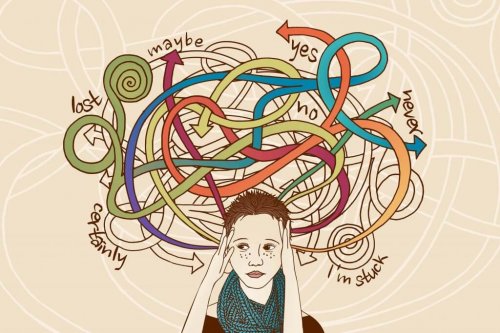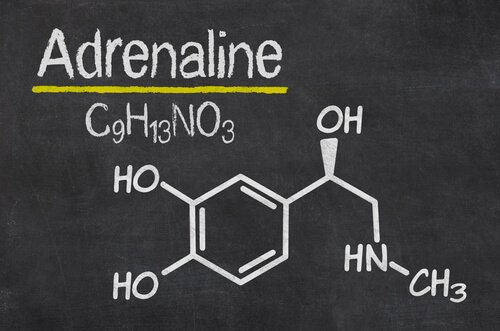What Exactly is the Stress Response?

Everyone has experienced stress before. Stress affects different aspects of your day-to-day life and can even condition you in certain ways. But do you know what the stress response is?
Stress manifests when there is cumulative fatigue in different bodily systems after prolonged or poorly regulated responses. We’re referring to allostatic load, which is the price the body pays when it has to adapt to adverse circumstances.
To prevent this from happening, your body has adaptive processes that spring into action in stressful situations. These processes seek to achieve balance or homeostasis.
The body always tries to return to a stable state after suffering homeostatic imbalances. How exactly does the body do this? Discover it below!

The stress response
When the body detects stress, it sets a series of physiological and metabolic responses in action in order to adapt. These responses arise when you exercise, for example. They also make it easier for you to evaluate any situation. In stressful situations, they help you become more alert and vigilant and enable you to make quicker decisions.
The first system that stress activates is the autonomic nervous system. After that, the hypothalamus takes over to integrate sensory and emotional information.
The hypothalamus also activates the paraventricular nucleus, which in turn activates the preganglionic neurons of the spinal cord. These neurons activate the sympathetic chain ganglia that increase noradrenaline in certain organs.
Effects of increased noradrenaline release during the stress response
- Increased heart rate.
- Vasodilation of the coronary arteries.
- Relaxation of the bronchial musculature.
- Rapid breathing.
- Peripheral vasoconstriction.
- Hepatic glycogenolysis.
- Hyperglycemia.
When the sympathetic chain ganglia activate, so do the adrenal glands. That, in turn, increases the release of adrenaline in addition to noradrenaline.
These last two directly activate non-innervated structures through the sympathetic nervous system. They also reinforce the prior effects of noradrenaline.
Effects of increased adrenaline
- Increased heart rate.
- Muscular and cardiac vasodilation.
- Dilation of the respiratory system (which facilitates pulmonary air circulation).
- Increased sweating (to get rid of excess heat).
- A decrease in non-vital physiological processes (inflammation, digestion, reproduction, and growth).
- It stimulates hepatic glycogenolysis (glucose production).
- Inhibits insulin release and stimulates glucagon in the pancreas (high glucose levels).
In response to the noradrenaline, the salivary glands also release an oral enzyme called alpha-amylase. This enzyme helps digest carbohydrates and eliminates bacteria in the mouth.

The hypothalamic-pituitary-adrenal axis
When the hypothalamus activates the paraventricular nucleus, certain neurons in this nucleus release the neurohormone CRF to the system that connects the hypothalamus with the anterior pituitary gland. That, in turn, stimulates the release of the corticotrophin hormone into the bloodstream.
ACTH activates the formation of glucocorticoids like cortisol. This is a steroid hormone that intervenes in the metabolism of carbohydrates, protein, and fats. It stimulates glucose synthesis and also makes cells moderately reduce their glucose consumption, which elevates glycemia.
Glucocorticoids like cortisol give negative feedback to the hypothalamus and the pituitary gland. So, they regulate the respective concentration of ACTH and CRF. These hormones also act on the immune system and on the hippocampus.
This axis normally releases hormones according to circadian rhythms associated with sleep-wake periods. Consequently, in the morning, the cortisol concentration is higher than at night.
Thus, when your body responds to stress, the hypothalamus projects to the sympathetic nervous system. That produces certain effects:
Effects of sympathetic activation
- Hepatic glycogenolysis.
- Hyperglycemia.
- Rapid breathing.
- Rapid heartbeat and increased blood pressure.
- Peripheral vasoconstriction and muscular vasodilation.
- Increased alertness and reaction time.
- Increased muscular contraction.
- Dilated pupils.

Neural control of the stress response
To register the stress response, there are two possible paths according to the stimulus they receive: systemic and psychogenic.
Systemic
- First of all, the stimuli don’t require conscious processing.
- These tend to be physiological threats (like hemorrhages, for example).
- Direct activation of the paraventricular nucleus of the hypothalamus.
Psychogenic
- The stimuli require conscious processing.
- They don’t imply immediate danger.
- Indirect activation of the paraventricular nucleus of the hypothalamus.
In conclusion, the stress response is when the body sets in motion a series of processes in order to maintain balance and stop the undesired effects of stress. This is just another example of nature’s incredible wisdom.
Everyone has experienced stress before. Stress affects different aspects of your day-to-day life and can even condition you in certain ways. But do you know what the stress response is?
Stress manifests when there is cumulative fatigue in different bodily systems after prolonged or poorly regulated responses. We’re referring to allostatic load, which is the price the body pays when it has to adapt to adverse circumstances.
To prevent this from happening, your body has adaptive processes that spring into action in stressful situations. These processes seek to achieve balance or homeostasis.
The body always tries to return to a stable state after suffering homeostatic imbalances. How exactly does the body do this? Discover it below!

The stress response
When the body detects stress, it sets a series of physiological and metabolic responses in action in order to adapt. These responses arise when you exercise, for example. They also make it easier for you to evaluate any situation. In stressful situations, they help you become more alert and vigilant and enable you to make quicker decisions.
The first system that stress activates is the autonomic nervous system. After that, the hypothalamus takes over to integrate sensory and emotional information.
The hypothalamus also activates the paraventricular nucleus, which in turn activates the preganglionic neurons of the spinal cord. These neurons activate the sympathetic chain ganglia that increase noradrenaline in certain organs.
Effects of increased noradrenaline release during the stress response
- Increased heart rate.
- Vasodilation of the coronary arteries.
- Relaxation of the bronchial musculature.
- Rapid breathing.
- Peripheral vasoconstriction.
- Hepatic glycogenolysis.
- Hyperglycemia.
When the sympathetic chain ganglia activate, so do the adrenal glands. That, in turn, increases the release of adrenaline in addition to noradrenaline.
These last two directly activate non-innervated structures through the sympathetic nervous system. They also reinforce the prior effects of noradrenaline.
Effects of increased adrenaline
- Increased heart rate.
- Muscular and cardiac vasodilation.
- Dilation of the respiratory system (which facilitates pulmonary air circulation).
- Increased sweating (to get rid of excess heat).
- A decrease in non-vital physiological processes (inflammation, digestion, reproduction, and growth).
- It stimulates hepatic glycogenolysis (glucose production).
- Inhibits insulin release and stimulates glucagon in the pancreas (high glucose levels).
In response to the noradrenaline, the salivary glands also release an oral enzyme called alpha-amylase. This enzyme helps digest carbohydrates and eliminates bacteria in the mouth.

The hypothalamic-pituitary-adrenal axis
When the hypothalamus activates the paraventricular nucleus, certain neurons in this nucleus release the neurohormone CRF to the system that connects the hypothalamus with the anterior pituitary gland. That, in turn, stimulates the release of the corticotrophin hormone into the bloodstream.
ACTH activates the formation of glucocorticoids like cortisol. This is a steroid hormone that intervenes in the metabolism of carbohydrates, protein, and fats. It stimulates glucose synthesis and also makes cells moderately reduce their glucose consumption, which elevates glycemia.
Glucocorticoids like cortisol give negative feedback to the hypothalamus and the pituitary gland. So, they regulate the respective concentration of ACTH and CRF. These hormones also act on the immune system and on the hippocampus.
This axis normally releases hormones according to circadian rhythms associated with sleep-wake periods. Consequently, in the morning, the cortisol concentration is higher than at night.
Thus, when your body responds to stress, the hypothalamus projects to the sympathetic nervous system. That produces certain effects:
Effects of sympathetic activation
- Hepatic glycogenolysis.
- Hyperglycemia.
- Rapid breathing.
- Rapid heartbeat and increased blood pressure.
- Peripheral vasoconstriction and muscular vasodilation.
- Increased alertness and reaction time.
- Increased muscular contraction.
- Dilated pupils.

Neural control of the stress response
To register the stress response, there are two possible paths according to the stimulus they receive: systemic and psychogenic.
Systemic
- First of all, the stimuli don’t require conscious processing.
- These tend to be physiological threats (like hemorrhages, for example).
- Direct activation of the paraventricular nucleus of the hypothalamus.
Psychogenic
- The stimuli require conscious processing.
- They don’t imply immediate danger.
- Indirect activation of the paraventricular nucleus of the hypothalamus.
In conclusion, the stress response is when the body sets in motion a series of processes in order to maintain balance and stop the undesired effects of stress. This is just another example of nature’s incredible wisdom.
All cited sources were thoroughly reviewed by our team to ensure their quality, reliability, currency, and validity. The bibliography of this article was considered reliable and of academic or scientific accuracy.
- Kudielka, B. M., Hellhammer, D. H., & Wüst, S. (2009). Why do we respond so differently? Reviewing determinants of human salivary cortisol responses to challenge. Psychoneuroendocrinology, 34(1), 2-18.
- Sandi, C. (2013). Stress and cognition. Wiley Interdisciplinary Reviews: Cognitive Science, 4(3), 245-261.
- Valdés, M., & De Flores, T. (1985). Psicobiología del estrés. Barcelona: Martínez Roca, 2.
This text is provided for informational purposes only and does not replace consultation with a professional. If in doubt, consult your specialist.







